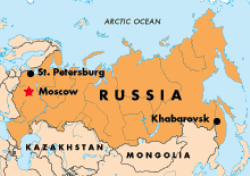Sergei Kiriyenko was born in 1962 in Sukhum, the capital of Abkhazia, and grew up in Sochi, in southern Russia. After graduation from high school, Kiriyenko enrolled in the shipbuilding faculty at the Nizhny Novgorod (Gorky) Water Transport Engineers Institute, where his divorced father taught. At this time, he dropped the Jewish family name of his father and adopted Kiriyenko, the Ukrainian name of his mother.
Party Youth
After graduation he began his work at the Red Sormovo Shipbuilding factory in Nizhny Novgorod, which produced parts for nuclear submarines. Like many other figures in contemporary Russian politics and business, Kiriyenko's real career began in the Komsomol, the youth wing of the Communist Party, at first as the Komsomol leader in his factory and then as a first secretary in the organization's Nizhnegorodskaya (Gorkovskaya) Oblast branch.
When Soviet President Mikhail Gorbachev began the liberalization of the economy in the late 1980s, Kiriyenko went into business and became the head of the Komsomol-run trading and services company, AMK. At this time, he was also involved in organizing scratch-card lotteries -- he even invented a special type of scratchcard, which he patented in 1997, according to peoples.ru.
After finishing a two-year management course at the government-funded National Economy Academy, in 1993 Kiriyenko became the head of a commercial bank, Garantiya. In 1996, he was appointed chairman of the board of a medium-sized oil company, Norsi-oil.
Kiriyenko was linked politically with then-governor of Nizhny Novgorod Oblast, Boris Nemtsov. Kiriyenko was an active member of the Union of Rightist Forces, which was co-chaired by Nemtsov. When Nemtsov moved to Moscow in 1997 to become a first deputy to Prime Minister Viktor Chernomyrdin, he brought Kiriyenko with him. In 1997, Kiriyenko was appointed first deputy fuel and energy minister and then later became minister proper.
In November 1998, President Boris Yeltsin appointed Kiriyenko, then relatively unknown outside the government, as prime minister. For his baby face and surprise entrance into top politics, the Russian media dubbed Kiriyenko "Kinder surprise," a reference to popular chocolate eggs containing surprise toys.
He lived up to the nickname when, on 17 August 1998, Russia unexpectedly descended into financial default and Boris Yeltsin forced Kiriyenko and his government to resign.
From Yeltsin To Putin
But as a politician, Kiriyenko survived. In 1999, he led the Union of Rightist Forces to modest success in parliamentary elections. But his true political second coming was shepherded by President Vladimir Putin, who was likely attracted by Kiriyenko's political loyalty and reputation as an able manager.
Kiriyenko (left) and his government were dismissed by then President Boris Yeltsin following the 1998 ruble crisis (TASS)
Kiriyenko (left) and his government were fired by then President Boris Yeltsin after the 1998 ruble crisis (TASS)Putin, likely satisfied with Kiriyenko's performance in the potentially troublesome region, then appointed him as the head of the national nuclear agency, Rosatom. Putin said that he expected Kiriyenko to revitalize Russia's decaying nuclear power sector, RIA Novosti reported on 22 November 2005." Kiriyenko has been transferred...not [just] to head an agency. It will not be enough. I believe that, in this sector, we have obvious advantages, accumulated from previous decades, and we should not lose them," the Russian president was quoted as saying.
Following his appointment, Kiriyenko announced an ambitious program to increase Russia's share of nuclear energy generation from the current 16-17 percent to 25 percent by 2030. To do so, Rosatom plans to build up to 40 new reactors at a cost of $60 billion. By comparison, since the fall of the Soviet Union, Russia has built (or is building) only eight reactors, five in Russia and others in China, India, and Iran.
Within the framework of Putin's plan to make Russia an "energy superpower," Kiriyenko has suggested integrating all Russian nuclear centers, research, and production facilities into a single state corporation, ITAR-TASS reported on 9 February. He also suggested that, in the next 20 years, Russia should control up to 20 percent of the world atomic energy market by exporting its nuclear technology.
In perhaps his most daunting task, Putin has charged Kiriyenko with the sensitive mission of negotiating with Tehran about the possibility of building a uranium-conversion facility in Russia.
Russia's Nuclear Power Sector
 Click on the map to view the locations of Russia's civilian nuclear power plants.
Click on the map to view the locations of Russia's civilian nuclear power plants.
POWER OF THE ATOM: As Russia's economy recovers from the collapse of the 1990s, the government is moving forward with plans to expand its nuclear-energy sector. Russia currently has 31 civilian nuclear-power reactors in operation, with the newest being Kalinin-3, which came on line in 2004. Nuclear power accounts for 16 percent of Russia's total power generation. Three additional reactors are currently under construction.
Many of Russia's reactors are quite old. In 2000, the government announced plans to extend the working lifetime of 12 first-generation reactors. So far, seven of these reactors have been upgraded for 15-year extensions and all 12 of them are expected to be replaced by 2020.
Russia controls about 4 percent of the world's known uranium deposits, producing some 2,900 tons of uranium in 2002. Russia has four operating uranium-enrichment plants, the largest of which is located at Novouralsk near Yekaterinburg.
The government has not yet approved a proposal for a permanent nuclear-waste storage facility on the Kola Peninsula.











